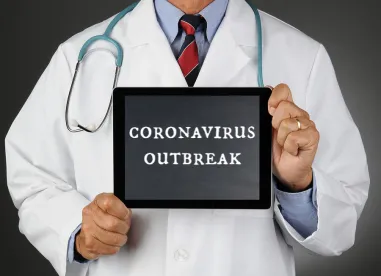Between various blanket Section 1135 waivers and state specific waivers issued by CMS, provisions of the Coronavirus Aid, Relief, and Economic Security Act (the CARES Act) and numerous state, local and accreditation body guidance documents and regulations, including a recent COVID-19 Interim Final Rule issued by CMS (IFC), significant changes to standard conditions of payment and participation for post-acute providers have been made to ease burdens faced by post-acute care providers and increase access to care for patients as a result of the impacts of the COVID-19 public health emergency (PHE). Additionally, CMS has now issued blanket waivers under the Stark physician self-referral law that require physicians that refer designated health services such as home health, durable medical equipment, or therapy services to a provider with whom they have either a compensation arrangement (e.g., medical director) or ownership relationship to meet a fair market value or other designated exception for those financial arrangements to be appropriate.
The end goals of each of these changes are primarily to: a) facilitate placement of non COVID-19 patients in non-acute settings where clinically appropriate in order to free inpatient acute care bed capacity; and b) limit potential spread of the disease amongst patients and clinicians by allowing remote care and/or allowing patient transfers between care settings to isolate COVID-19 patients from the general population. Important opportunities and takeaways arise from these developments for all post-acute players. Some of the most notable changes along with important takeaways are presented below. While a general overview is presented herein, note that precise waivers and flexibilities for each category of post-acute care provider continue to evolve daily as regulators work to ease burdens of and barriers to providing care to patients.
Specific Changes
Home Health
The CARES Act authorizes CMS to issues regulations that would allow nurse practitioners and physician assistants, in addition to physicians, to order home health services. This expansion of home health prescribing authority has been implemented in the Medicare and Medicaid contexts through the IFC, Section 1135 waivers, and informal guidance documents, subject to compliance with state laws. Moreover, CMS has issued an 1135 waiver to allow the determination of homebound status to be made via a record review or remotely via telemedicine and in the IFC the definition of homebound status was expanded to patients whose physicians have advised them not to leave the home due to a confirmed, or suspected, COVID-19 diagnosis, or if the patient has a condition that makes them more susceptible to contracting COVID-19. Additional blanket Section 1135 waivers were issued/clarified on March 30, 2020 related to an extension of auto-cancellation of requests for anticipated payments, certain OASIS reporting requirements, initial assessments, and onsite visits for home health agency aide supervision.
Hospice
The CARES Act now waives the face-to-face requirement for hospice episode recertification by allowing the same to be performed via telemedicine modalities. This waiver was implemented by the IFC and for the duration of the COVID-19 PHE permits either a hospice physician or nurse practitioner to satisfy the face-to-face requirement via using real-time interactive audio and video technology but solely for the purpose of recertifying a patient for hospice services during the COVID-19 PHE. (However, these visits are not separately billable and are considered an administrative expense.) Additionally, in the IFC, for the duration of the COVID-19 PHE, CMS amended applicable regulations to permit hospice services to be carried out via telecommunications system when the patient is also receiving routine home care and it is feasible and appropriate to do so to ensure Medicare patient can continue receiving services without jeopardizing the patient’s health or the health of those providing such services. However, the use of such technology must be included in a patient plan of care. The cost of the telecommunications technology may be reported by the hospice as “other patient care services” using Worksheet A, cost center line 46, or a subscript of line 46 through 46.19, cost center code 4600 through 4619, and identifying this cost center as “PHE for COVID-19”. In the IFC, CMS requested comments from industry stakeholders regarding both amendments. Additional blanket 1135 waivers were issued/clarified on March 30, 2020 related to use of volunteers, comprehensive assessments, non-core services and requirements for onsite visits for hospice aide supervision.
Skilled Nursing Facilities (SNF)
CMS has waived the requirement for a 3-day inpatient hospital stay prior to SNF admission. Anecdotally many state departments of public health are now allowing SNFs to move non COVID-19 patients to new locations to facilitate making certain SNFs COVID-19 dedicated sites. CMS has issued a blanket 1135 waiver to use and/or redeploy areas of a SNF or non SNF adjacent buildings to be used for skilled care provided state licensure and regulatory bodies allow same. Additional blanket 1135 waivers were issued/clarified on March 30, 2020 related to the 3-day prior hospitalization rule, minimum data set reporting, staffing data submissions, pre-admission screening requirements, and annual resident reviews.
Inpatient Rehabilitation Facilities (IRF)
The CARES Act waives the requirement for IRFs to provide a minimum of 15 hours per week of therapy services. Additionally, CMS has waived a) the requirement that at least 60% of inpatients qualify clinically for IRF treatment (as opposed to non-IRF acute care services); and b) has allowed acute care hospitals with distinct part units (DPUs) the flexibility to transfer non-COVID-19 patients between acute care licensed beds and DPU licensed beds to free up additional bed capacity. Additionally, through the IFC, CMS has, for the duration of the COVID-19 PHE, revised applicable regulations to allow the face-to-face visit requirements normally imposed in the IRF setting to be conducted via telehealth to safeguard the health and safety of Medicare beneficiaries and the rehabilitation physicians treating them. CMS had indicated that they welcome feedback with respect to this change.
Long-Term Care Hospitals (LTCH)
The CARES Act requires CMS to waive a) the 50% requirement on clinical eligibility; b) the site neutrality requirements for LTCHs pending the duration of the PHE; and c) the 25-day average length of stay requirement to allow LTCHs to be paid at the LTCH rate when there are early discharges to meet the demands of the COVID-19 PHE.
Assisted Living
There is no comprehensive regulation at the federal level of assisted living and senior housing. However, several developments portend an expansion and increase in clinical complexity of residents of senior housing facilities. These include the expansion of Medicaid community based waiver programs, above noted home health and hospice changes, pre-COVID-19 changes resulting in expansion of Medicare Advantage hospice, personal care and related services both in person and remotely. Confirming the critical importance of senior and assisted living facilities within the COVID-19 crisis, the Department Of Labor included assisted living and retirement communities in the definition of essential healthcare providers for purposes of exemption from the CARES Act’s sick pay and FMLA expansion provisions.
Key Takeaways
What should post acute care providers do to take advantage of these developments?
-
Take hold of COVID-19 waivers and expand and integrate telemedicine immediately. This will protect your work force, reduce costs and allow you to retain or increase census. While many of the changes allowing greater flexibility in location, patient relationship and physician privilege/qualification have been at the federal level, including the availability of certain grants, do consult state Medicaid, commercial insurance, Medicare Advantage, and payor and regulatory bodies regarding other added flexibilities.
-
Evaluate available capacity across the platform for inpatient care to assess potential utilization as an alternative care setting. Looking at state regulations, local health system needs and the above CMS waivers to match capacity and need to find revenue opportunities.
-
Assess the need for additional medical directors to triage patients to the right setting of care. The COVID-19 Stark waivers contemplate justified purposes to include creating greater capacity in the system for non COVID-19 patients as COVID-19 patients begin to overload acute care systems.
-
Engage with ambulatory surgery centers and other outpatient centers, system created “field” hospitals and physician practices to explore possible partnership arrangements to manage COVID-19 surges. Engage with primary care physician practices to bring more primary care, either directly or remotely, into the home, which can include assisted living, SNFs, memory care and retirement facilities. While both federal and state anti-kickback laws remain in place and abusive or fraudulent schemes should of course be avoided, the Office of Inspector General (OIG) has commented that they place a high priority on providing the health care community with the flexibility to provide needed care during the PHE and for any conduct during this PHE that may be subject to OIG administrative enforcement, OIG will carefully consider the context and intent of the parties when assessing whether to proceed with any enforcement actions. This statement, along with the recent blanket Stark waivers will allow greater flexibility for post-acute providers to enter into necessary financial relationships to meet patient care needs during the COVID-19 crisis.
-
While for many years MEDPAC has discussed a site neutral payment regime for post-acute care, a solution has been elusive. Bundled payments, ACOs and other APMs have been the substitute, some with mixed results. While the focus of the COVID-19 crisis has largely been on inpatient acute care capacity expansion and clinician wellbeing, some of the changes in process that have occurred during the COVID-19 PHE will likely have permanent impact on patient discharge, admission and payment methods over the longer term.




 />i
/>i

